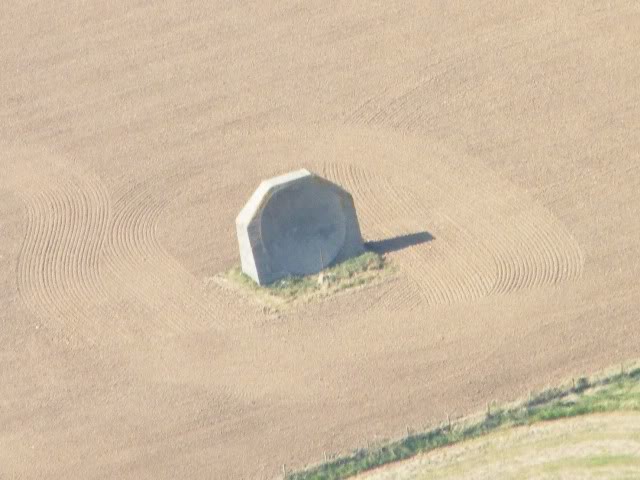The acoustic mirror at Kilnsea in the East Riding of Yorkshire is one of a number built on the northeast coast of England during the First World War.
A forerunner of radar, they were intended to provide early warning of incoming enemy aeroplanes and airships about to attack east coast towns.

Photo: Mark Dyson, March 2003.
The mirror is made of concrete, with a dish about 15 feet in diameter in the side facing the sea.
It worked by focusing the noise of aircraft engines onto a microphone, which amplified the sound. In this way the relatively slow aircraft of the time could be heard and located before they came into view.
The microphone would have been fitted to the metal post set in a concrete block in front of the mirror. An operator would use headphones to listen for an approaching enemy.

Photo: Roland Schmellenkamp, September 2011.
With the development of faster aircraft the sound mirrors became less useful, as an aircraft would be within sight by the time it had been located.

Photo: Andrew Grantham, December 2001.
The sound mirror stands behind a nature reserve in a field just north of Kilnsea at the landward end of Spurn Head. It is set back from the current coastline (which is eroding nearer every year), possibly to prevent the noise from waves breaking on the shore interfering with the operation of the mirror.
![The Kilnsea sound mirror from the south in December 2001 [Picture of the Kilnsea mirror from the south]](/images/mirror/kilnsea2small.jpg)
Photo: Andrew Grantham, December 2001.
Other sound mirrors were built at Boulby, Redcar, Hartlepool, Seaham and Sunderland. Further examples existed on the south coast.

Photo: Roland Schmellenkamp, September 2011.
Location

Photo: Roland Schmellenkamp, September 2011.
The mirror is roughly between Kilnsea Grange and the sea.
View Sound mirrors in a larger map
More
- News and updates about the Kilnsea sound mirror.
- Wilgilsland – history of Spurn and Kilnsea.
- SKEALS – the Spurn, Kilnsea & Easington Area Local Studies Group.

So nice to see this mirror is now fenced and looked after. Preserving a mirror for future. Nice unusual huge WWII buildings in the area and a ROC post.
What will happen to the mirror when the sea reaches it. Will it be saved or lost?
There is an essay at https://scholar.valpo.edu/cgi/viewcontent.cgi?article=1195&context=journaloftolkienresearch linking this mirror to the wartime service of J R R Tolkien, author of “The Hobbit” and “The Lord of the Rings”
On a field trip to Spurn from our primary school c1962 we were told by the official showing us around the old Great War buildings that were still on the peninsular at that time, that the sound mirrors were manned by blind people who had much more acute hearing than sighted people.
Please see Tolkien and the Kilnsea Sound Mirror.